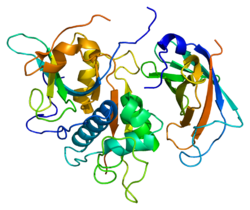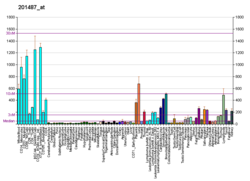카테핀 C
Cathepsin C| CTSC | |||||||||||||||||||||||||
|---|---|---|---|---|---|---|---|---|---|---|---|---|---|---|---|---|---|---|---|---|---|---|---|---|---|
 | |||||||||||||||||||||||||
| |||||||||||||||||||||||||
| 식별자 | |||||||||||||||||||||||||
| 별칭 | CTSC, CPI, DPP-I, DPP1, DPI, HMS, JP, JPD, PALS, PDON1, PLS, 카테핀 C | ||||||||||||||||||||||||
| 외부 ID | OMIM: 602365 MGI: 109553 HomoloGene: 1373 GeneCard: CTSC | ||||||||||||||||||||||||
| |||||||||||||||||||||||||
| |||||||||||||||||||||||||
| |||||||||||||||||||||||||
| |||||||||||||||||||||||||
| 직교체 | |||||||||||||||||||||||||
| 종 | 인간 | 마우스 | |||||||||||||||||||||||
| 엔트레스 | |||||||||||||||||||||||||
| 앙상블 | |||||||||||||||||||||||||
| 유니프로트 | |||||||||||||||||||||||||
| RefSeq(mRNA) | |||||||||||||||||||||||||
| RefSeq(단백질) | |||||||||||||||||||||||||
| 위치(UCSC) | Chr 11: 88.27 – 88.36Mb | Cr 7: 87.93 – 87.96Mb | |||||||||||||||||||||||
| PubMed 검색 | [3] | [4] | |||||||||||||||||||||||
| 위키다타 | |||||||||||||||||||||||||
| |||||||||||||||||||||||||
| 카테신 C 제외 도메인 | |||||||||
|---|---|---|---|---|---|---|---|---|---|
 인간 디펩티딜 펩티다아제의 고유구조 재결정( cpsin c) | |||||||||
| 식별자 | |||||||||
| 기호 | 카테터신C_exc | ||||||||
| Pfam | PF08773 | ||||||||
| 인터프로 | IPR014882 | ||||||||
| SCOP2 | 1k3b / SCOPe / SUPFAM | ||||||||
| |||||||||
디펩티딜 펩티다아제 I(DPP-I)로도 알려진 카테신 C(Cathetpsin C)는 시스테인 카테핀의 하위그룹인 펩티다아제 C1 단백질군에 속하는 리소솜 엑소-시스테인 프로테아제다.인간에서는 CTSC 유전자에 의해 암호화된다.[5][6]
함수
카테신 C는 면역/염증 세포에서 많은 세린 프로테아제의 활성화를 위한 중앙 조정자로 보인다.
Cathepsin C catalyses excision of dipeptides from the N-terminus of protein and peptide substrates, except if (i) the amino group of the N-terminus is blocked, (ii) the site of cleavage is on either side of a proline residue, (iii) the N-terminal residue is lysine or arginine, or (iv) the structure of the peptide or protein prevents further digestiN-terminus로 부터.
구조
쥐, 인간, 머린, 소, 개, 그리고 두 개의 슈스토솜 카테핀 Cs를 인코딩하는 cDNA는 복제되고 염기서열화되었으며 효소가 매우 보존되어 있다는 것을 보여준다.[7]인간과 랫드 카테핀 CDNA는 24개 잔류물의 신호 펩타이드, 205개(랫드 카테핀 C) 또는 206개(인간 카테핀 C) 잔류물의 프로-레인지 및 233개 잔류물의 촉매영역으로 구성되며 촉매 잔류물을 포함하고 있으며, 파핀과 파핀의 성숙한 아미노산 시퀀스와 30-40% 동일하다.도뇨관, B, H, K, L, S를 포함한 다른 도뇨관.[8]
번역된 프리프로-카텝신 C는 폴리펩타이드 체인의 최소 4개 분할에 의해 성숙한 형태로 처리된다.신호 펩타이드(pro-cathepsin C)는 프로-엔자임(pro-enjyme, pro-cathepsin C)의 변환이나 분비 중에 제거되며 성숙한 효소에 보존되는 큰 N-terminal proregion 파편(일명 제외 영역)[9]은 활성화 펩타이드라고 불리는 프로-region의 경미한 C-terminal 부분의 절제에 의해 촉매영역에서 분리된다.약 164개의 잔류물의 무거운 사슬과 약 69개의 잔류물의 가벼운 사슬은 촉매 영역의 갈라짐으로 생성된다.
성숙한 카테핀 C는 교황과의 다른 구성원과 달리 4개의 하위 단위로 구성되며, 각각 N-단자 프로그레시온 파편, 헤비 체인, 라이트 체인으로 구성된다.프로 지역 파편과 헤비 체인은 모두 글리코실화 되어 있다.
임상적 유의성
인코딩된 단백질의 결함은 팜플란트 각막염과 치주염으로 특징지어지는 자가 열성 장애인 [10][11]Papillon-Lefebre 질환의 원인인 것으로 밝혀졌다.
카테신 C는 중성미 세포의 엘라스타아제, 카테신 G와 같은 염증 세포의 그래뉴 세린 펩타아제 활성화의 핵심 효소로서 기능하고, 마스트 세포의 키마제와 트립타제.류마티스 관절염, 만성폐쇄성폐질환(COPD), 염증성 장질환, 천식, 패혈증, 낭포성 섬유증 등 많은 염증성 질환에서 병원체 발생의 상당 부분은 이러한 염증성 보호제의 활동성 증가에 의해 발생한다.카테핀 C에 의해 활성화되면 프로테아제는 세포외 여러 가지 기질 성분을 분해할 수 있어 조직 손상과 만성 염증을 유발할 수 있다.
참조
- ^ a b c GRCh38: 앙상블 릴리스 89: ENSG00000109861 - 앙상블, 2017년 5월
- ^ a b c GRCm38: 앙상블 릴리스 89: ENSMUSG000030560 - 앙상블, 2017년 5월
- ^ "Human PubMed Reference:". National Center for Biotechnology Information, U.S. National Library of Medicine.
- ^ "Mouse PubMed Reference:". National Center for Biotechnology Information, U.S. National Library of Medicine.
- ^ "Entrez Gene: CTSC cathepsin C".
- ^ Paris A, Strukelj B, Pungercar J, Renko M, Dolenc I, Turk V (Aug 1995). "Molecular cloning and sequence analysis of human preprocathepsin C". FEBS Letters. 369 (2–3): 326–30. doi:10.1016/0014-5793(95)00777-7. PMID 7649281. S2CID 45737414.
- ^ Hola-Jamriska L, Tort JF, Dalton JP, Day SR, Fan J, Aaskov J, Brindley PJ (Aug 1998). "Cathepsin C from Schistosoma japonicum--cDNA encoding the preproenzyme and its phylogenetic relationships". European Journal of Biochemistry. 255 (3): 527–34. doi:10.1046/j.1432-1327.1998.2550527.x. PMID 9738890.
- ^ Kominami E, Ishido K, Muno D, Sato N (Jul 1992). "The primary structure and tissue distribution of cathepsin C". Biological Chemistry Hoppe-Seyler. 373 (7): 367–73. doi:10.1515/bchm3.1992.373.2.367. PMID 1515062.
- ^ Turk D, Janjić V, Stern I, Podobnik M, Lamba D, Dahl SW, Lauritzen C, Pedersen J, Turk V, Turk B (Dec 2001). "Structure of human dipeptidyl peptidase I (cathepsin C): exclusion domain added to an endopeptidase framework creates the machine for activation of granular serine proteases". The EMBO Journal. 20 (23): 6570–82. doi:10.1093/emboj/20.23.6570. PMC 125750. PMID 11726493.
- ^ Wani AA, Devkar N, Patole MS, Shouche YS (Feb 2006). "Description of two new cathepsin C gene mutations in patients with Papillon-Lefèvre syndrome". Journal of Periodontology. 77 (2): 233–7. doi:10.1902/jop.2006.050124. PMID 16460249.
- ^ Meade JL, de Wynter EA, Brett P, Sharif SM, Woods CG, Markham AF, Cook GP (May 2006). "A family with Papillon-Lefevre syndrome reveals a requirement for cathepsin C in granzyme B activation and NK cell cytolytic activity". Blood. 107 (9): 3665–8. doi:10.1182/blood-2005-03-1140. PMID 16410452.
추가 읽기
- McGuire MJ, Lipsky PE, Thiele DL (Jun 1992). "Purification and characterization of dipeptidyl peptidase I from human spleen". Archives of Biochemistry and Biophysics. 295 (2): 280–8. doi:10.1016/0003-9861(92)90519-3. PMID 1586157.
- Paris A, Strukelj B, Pungercar J, Renko M, Dolenc I, Turk V (Aug 1995). "Molecular cloning and sequence analysis of human preprocathepsin C". FEBS Letters. 369 (2–3): 326–30. doi:10.1016/0014-5793(95)00777-7. PMID 7649281. S2CID 45737414.
- Dolenc I, Turk B, Pungercic G, Ritonja A, Turk V (Sep 1995). "Oligomeric structure and substrate induced inhibition of human cathepsin C". The Journal of Biological Chemistry. 270 (37): 21626–31. doi:10.1074/jbc.270.37.21626. PMID 7665576.
- Maruyama K, Sugano S (Jan 1994). "Oligo-capping: a simple method to replace the cap structure of eukaryotic mRNAs with oligoribonucleotides". Gene. 138 (1–2): 171–4. doi:10.1016/0378-1119(94)90802-8. PMID 8125298.
- Rao NV, Rao GV, Hoidal JR (Apr 1997). "Human dipeptidyl-peptidase I. Gene characterization, localization, and expression". The Journal of Biological Chemistry. 272 (15): 10260–5. doi:10.1074/jbc.272.15.10260. PMID 9092576.
- Fischer J, Blanchet-Bardon C, Prud'homme JF, Pavek S, Steijlen PM, Dubertret L, Weissenbach J (1997). "Mapping of Papillon-Lefevre syndrome to the chromosome 11q14 region". European Journal of Human Genetics. 5 (3): 156–60. doi:10.1159/000484751. hdl:2066/24363. PMID 9272739.
- Suzuki Y, Yoshitomo-Nakagawa K, Maruyama K, Suyama A, Sugano S (Oct 1997). "Construction and characterization of a full length-enriched and a 5'-end-enriched cDNA library". Gene. 200 (1–2): 149–56. doi:10.1016/S0378-1119(97)00411-3. PMID 9373149.
- Cigić B, Krizaj I, Kralj B, Turk V, Pain RH (Jan 1998). "Stoichiometry and heterogeneity of the pro-region chain in tetrameric human cathepsin C". Biochimica et Biophysica Acta (BBA) - Protein Structure and Molecular Enzymology. 1382 (1): 143–50. doi:10.1016/S0167-4838(97)00173-8. PMID 9507095.
- Toomes C, James J, Wood AJ, Wu CL, McCormick D, Lench N, Hewitt C, Moynihan L, Roberts E, Woods CG, Markham A, Wong M, Widmer R, Ghaffar KA, Pemberton M, Hussein IR, Temtamy SA, Davies R, Read AP, Sloan P, Dixon MJ, Thakker NS (Dec 1999). "Loss-of-function mutations in the cathepsin C gene result in periodontal disease and palmoplantar keratosis". Nature Genetics. 23 (4): 421–4. doi:10.1038/70525. PMID 10581027. S2CID 11433166.
- Hart TC, Hart PS, Bowden DW, Michalec MD, Callison SA, Walker SJ, Zhang Y, Firatli E (Dec 1999). "Mutations of the cathepsin C gene are responsible for Papillon-Lefèvre syndrome". Journal of Medical Genetics. 36 (12): 881–7. doi:10.1136/jmg.36.12.881 (inactive 28 February 2022). PMC 1734286. PMID 10593994.
{{cite journal}}: CS1 maint : 2022년 2월 현재 DOI 비활성화(링크) - Hart TC, Hart PS, Michalec MD, Zhang Y, Firatli E, Van Dyke TE, Stabholz A, Zlotogorski A, Shapira L, Soskolne WA, Zlorogorski A (Feb 2000). "Haim-Munk syndrome and Papillon-Lefèvre syndrome are allelic mutations in cathepsin C". Journal of Medical Genetics. 37 (2): 88–94. doi:10.1136/jmg.37.2.88. PMC 1734521. PMID 10662807.
- Hart TC, Hart PS, Michalec MD, Zhang Y, Marazita ML, Cooper M, Yassin OM, Nusier M, Walker S (Feb 2000). "Localisation of a gene for prepubertal periodontitis to chromosome 11q14 and identification of a cathepsin C gene mutation". Journal of Medical Genetics. 37 (2): 95–101. doi:10.1136/jmg.37.2.95. PMC 1734516. PMID 10662808.
- Suzuki Y, Ishihara D, Sasaki M, Nakagawa H, Hata H, Tsunoda T, Watanabe M, Komatsu T, Ota T, Isogai T, Suyama A, Sugano S (Mar 2000). "Statistical analysis of the 5' untranslated region of human mRNA using "Oligo-Capped" cDNA libraries". Genomics. 64 (3): 286–97. doi:10.1006/geno.2000.6076. PMID 10756096.
- Cigić B, Dahl SW, Pain RH (Oct 2000). "The residual pro-part of cathepsin C fulfills the criteria required for an intramolecular chaperone in folding and stabilizing the human proenzyme". Biochemistry. 39 (40): 12382–90. doi:10.1021/bi0008837. PMID 11015218.
- Hartley JL, Temple GF, Brasch MA (Nov 2000). "DNA cloning using in vitro site-specific recombination". Genome Research. 10 (11): 1788–95. doi:10.1101/gr.143000. PMC 310948. PMID 11076863.
- Hart PS, Zhang Y, Firatli E, Uygur C, Lotfazar M, Michalec MD, Marks JJ, Lu X, Coates BJ, Seow WK, Marshall R, Williams D, Reed JB, Wright JT, Hart TC (Dec 2000). "Identification of cathepsin C mutations in ethnically diverse papillon-Lefèvre syndrome patients". Journal of Medical Genetics. 37 (12): 927–32. doi:10.1136/jmg.37.12.927. PMC 1734492. PMID 11106356.
- Zhang Y, Lundgren T, Renvert S, Tatakis DN, Firatli E, Uygur C, Hart PS, Gorry MC, Marks JJ, Hart TC (Feb 2001). "Evidence of a founder effect for four cathepsin C gene mutations in Papillon-Lefèvre syndrome patients". Journal of Medical Genetics. 38 (2): 96–101. doi:10.1136/jmg.38.2.96. PMC 1734811. PMID 11158173.
- Nakano A, Nomura K, Nakano H, Ono Y, LaForgia S, Pulkkinen L, Hashimoto I, Uitto J (Feb 2001). "Papillon-Lefèvre syndrome: mutations and polymorphisms in the cathepsin C gene". The Journal of Investigative Dermatology. 116 (2): 339–43. doi:10.1046/j.1523-1747.2001.01244.x. PMID 11180012.
- Allende LM, García-Pérez MA, Moreno A, Corell A, Carasol M, Martínez-Canut P, Arnaiz-Villena A (Feb 2001). "Cathepsin C gene: First compound heterozygous patient with Papillon-Lefèvre syndrome and a novel symptomless mutation". Human Mutation. 17 (2): 152–3. doi:10.1002/1098-1004(200102)17:2<152::AID-HUMU10>3.0.CO;2-#. PMID 11180601.
- Wiemann S, Weil B, Wellenreuther R, Gassenhuber J, Glassl S, Ansorge W, Böcher M, Blöcker H, Bauersachs S, Blum H, Lauber J, Düsterhöft A, Beyer A, Köhrer K, Strack N, Mewes HW, Ottenwälder B, Obermaier B, Tampe J, Heubner D, Wambutt R, Korn B, Klein M, Poustka A (Mar 2001). "Toward a catalog of human genes and proteins: sequencing and analysis of 500 novel complete protein coding human cDNAs". Genome Research. 11 (3): 422–35. doi:10.1101/gr.GR1547R. PMC 311072. PMID 11230166.










